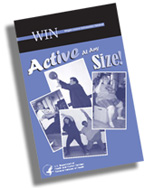
- Active at Any Size
- Why should I be active?
- How do I get started?
- What physical activities can a very large person do?
- Safety Tips
- Additional Resources
Do you feel that you can barely do any activity at all?
That you cannot exercise, play sports, or become more fit?

If you are a very large person,
you can still be physically active.
Very large people face special challenges in trying to be active. You may not be able to bend or move in the same way that other people can. It may be hard to find clothes and equipment for exercising. You may feel self-conscious being physically active around other people.
Facing these challenges is hard—but it can be done!
The information in this booklet may help you start being more active and healthier—no matter what your size!
Being physically active may help you live longer and protect you from:
- diabetes
- heart disease and stroke
- high blood pressure
- osteoporosis (a disease leading to weak bones that may break easily)
If you have any of these health problems, being physically active may help control or improve your symptoms.
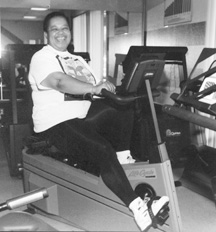
Regular physical activity helps you feel better because it:
- lowers your stress and boosts your mood
- increases your strength
- helps control blood pressure and blood sugar
- helps build healthy bones, muscles, and joints
- helps your heart and lungs work better
- improves your self-esteem.
Being physically active can be big fun!
Appreciate Yourself!
If you cannot do an activity, don’t be hard on yourself. Feel good about what you can do. Be proud of pushing yourself up out of a chair or walking a short distance.
Pat yourself on the back for trying even if you can’t do it the first time. It may be easier the next time!
To start being more active and keep at it:
- Start slowly. Your body needs time to get used to your new activity.
- Warm up. Warm-ups get your body ready for action. Shrug your shoulders, tap your toes, swing your arms, or march in place. You should spend a few minutes warming up for any physical activity—even walking. Walk more slowly for the first few minutes.
- Cool down. Slow down little by little. If you have been walking fast, walk slowly or stretch for a few minutes to cool down. Cooling down may protect your heart, relax your muscles, and keep you from getting hurt.
- Set goals. Set short-term and long-term goals. A short-term goal may be to walk 5 minutes on at least 3 days for 1 week. It may not seem like a lot, but any activity is better than none. A long-term goal may be to walk 30 minutes on most days of the week by the end of 6 months.
- Get support. Get a family member or friend to be physically active with you. It may be more fun, and your buddy can cheer you on.
- Track progress. Keep a journal of your physical activity. You may not feel like you are making progress but when you look back at where you started, you may be pleasantly surprised!
- Have fun! Try different activities to find the ones you really enjoy..
What physical activities can a very large person do?
Do I need to see my health care provider before I start being physically active?
You should talk to your health care provider if you:
—have a chronic health problem such as diabetes, heart disease, asthma or arthritis
—have high blood pressure, high cholesterol, or personal or family history of heart disease, or
—are a woman over age 50 or a man over age 40.
Most very large people can do some or all of the physical activities in this booklet. You do not need special skills or a lot of equipment. You can do:
- Weight-bearing activities, like walking and golfing, which involve lifting or pushing your own body weight.
- Non-weight-bearing activities, like swimming and water workouts, which put less stress on your joints because you do not have to lift or push your own weight. If your feet or joints hurt when you stand, non-weight-bearing activities may be best for you.
- Lifestyle activities, like gardening, which do not have to be planned.
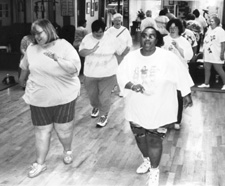
Physical activity does not have to be hard or boring to be good for you. Anything that gets you moving around—even for only a few minutes a day—is a healthy start to getting more fit.
Chances are your health care provider will be pleased with your decision to start an activity program. It is unlikely that you will need a complete medical exam before you go out for a short walk!
Gentle physical activity is healthy.
You do not have to push yourself to benefit from physical activity. Thirty minutes of gentle physical activity (like walking) can be just as healthy as 15 minutes of intense physical activity (like fast dancing).
The walking that you do during the day (like doing chores around the house or in the yard) can help you be more fit. But regular, steady walking that makes you breathe heavier can help you to be healthier. It will give your heart and lungs—as well as your leg muscles—a good workout.
If you are not active now, start slowly. Try to walk 5 minutes a day for the first week. Walk 8 minutes the next week. Stay at 8–minute walks until you feel comfortable. Then increase your walks to 11 minutes. Slowly lengthen each walk by 3 minutes—or walk faster.
Tips for walking:
- Wear comfortable walking shoes with a lot of support. If you walk often, you may need to buy new shoes every 6 to 8 months.
- Wear garments that prevent inner thigh chafing, such as tights or spandex shorts.
- Make walking fun. Walk with a friend or pet. Walk in places you enjoy, like a park or shopping mall.
To learn more, read the brochure Walking...A Step in the Right Direction from the Weight-control Information Network (WIN). (Available in English and Spanish)
Where to work out.
You can do many activities in your home. But there are other fun ways to be active in health clubs, in recreation centers, or outdoors. It may be hard to be physically active around other people. Keep in mind that you have just as much right to be healthy and active as anyone else.
Dancing (weight-bearing or non-weight-bearing)
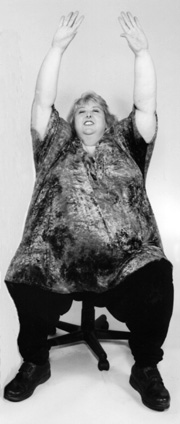
Dancing may help:
- tone your muscles
- improve your flexibility
- make your heart stronger
- make your lungs work better.
You can dance in a health club, in a nightclub, or at home. To dance at home, just move your body to some lively music!
Dancing on your feet is a weight-bearing activity. Dancing while seated lets you move your arms and legs to music while taking the weight off your feet. This may be a good choice if you can’t stand on your feet very long.
See the list of additional resources at the end of this booklet for seated workout videos.
Water Workouts (non-weight-bearing)
Exercising in water helps you feel:
Flexible. You can bend and move your body in water in ways you cannot on land.
Strong. Working against the water will help your body get stronger.
At less risk of injury. Water makes your body float. This keeps your joints from being pounded or jarred and helps prevent sore muscles and injury.
Refreshed. You can keep cooler in water—even when you are working hard.
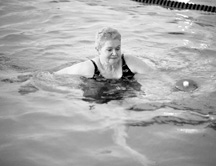 You
do not need to know how to swim to work out in water—you can
do shallow-water or deep-water exercises without swimming.
You
do not need to know how to swim to work out in water—you can
do shallow-water or deep-water exercises without swimming.
For shallow-water exercise, the water level should be between your waist and your chest. If the water is too shallow, it will be hard to move your arms underwater. If the water is deeper than chest height, it will be hard to keep your feet touching the pool bottom.
For deep-water exercise, most of your body is underwater. This means that your whole body will get a good workout. For safety and comfort, wear a foam belt or life jacket.
Many swim centers offer classes in water workouts. Check with the pools in your area to find the best water workout for you.
See the list of additional resources at the end of this booklet to learn more about water exercises.
Weight training rule of thumb.
If you cannot lift a weight 6 times in a row, the weight you are lifting is too heavy. If you can easily lift a weight 15 times in a row, your weight is too light.
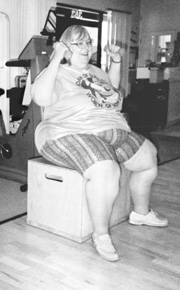 Weight Training (weight-bearing or non-weight-bearing)
Weight Training (weight-bearing or non-weight-bearing)
Weight training builds strong muscles and bones. Getting stronger can also help prepare you for other kinds of physical activity. You can weight train at home or at a fitness center.
You do not need benches or bars to begin weight training at home. You can use a pair of hand weights or even two soup cans.
Make sure you know the correct posture and that your movements are slow and controlled.
Before you buy a home gym, check its weight rating (the number of pounds it can support) to make sure it is safe for your size. If you want to join a fitness center where you can use weights, shop around for one where you feel at ease.
To learn more about weight training, see the list of additional resources at the end of this booklet.

Photograph courtesy of Bicycles by Haluzak, Santa Rosa, CA
Bicycling (non-weight-bearing)
You can bicycle indoors on a stationary bike, or outdoors on a road bike. Biking does not stress any one part of the body—your weight is spread between your arms, back, and hips.
You may want to use a recumbent bike. On this type of bike, you sit low to the ground with your legs reaching forward to the pedals. This may feel better than sitting upright. The seat on a recumbent bike is also wider than the seat on an upright bike.
For biking outdoors, you may want to try a mountain bike. These bikes have wider tires and are heavy. You can also buy a larger seat to put on your bike.
Make sure the bike you buy has a weight rating at least as high as your own weight..
To learn more about bicycling, see the list of additional resources at the end of this booklet.
Questions to ask when choosing a fitness center.
—Can the treadmills or benches support people who are large?
—Do the fitness staff know how to work with people of larger sizes?
—Can I take time to see how I like the center before I sign up?
—Is the aim to have fun and get healthy—not to lose weight?
Stretching (weight-bearing or non-weight-bearing)
Stretching may help you:
- be more flexible
- feel more relaxed
- improve your blood flow
- keep your muscles from getting tight after doing other physical activities.
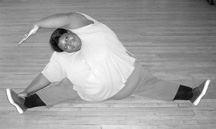 You do not have to set aside a special time or place to stretch. At home or at work, stand up, push your arms toward the ceiling, and stretch. Stretch slowly and only enough to feel tightness—not until you feel pain. Hold the stretch, without bouncing, for about 30 seconds. Do not stretch cold muscles.
You do not have to set aside a special time or place to stretch. At home or at work, stand up, push your arms toward the ceiling, and stretch. Stretch slowly and only enough to feel tightness—not until you feel pain. Hold the stretch, without bouncing, for about 30 seconds. Do not stretch cold muscles.
Yoga and tai chi are types of stretching. They help you breathe deeply, relax, and get rid of stress.
Your local fitness center may offer yoga, tai chi, or other stretching classes. You may want to start with “gentle” classes, like those aimed at seniors.
See the list of additional resources at the end of this booklet to learn more about these physical activities for large people.
Applaud yourself!
If you can do only a few or none of these activities, it’s OK. Remember to appreciate what you can do, even if you think it’s a small amount. Just moving any part of your body—even for a short time—can make you healthier.
Lifestyle physical activities do not have to be planned. You can make small changes to make your day more physically active and improve your health. For example,
- Take 2- to 3-minute walking breaks at work a few times a day.
- Put away the TV remote control—get up to change the channel.
- March in place during TV commercials.
- Sit in a rocking chair and push off the floor with your feet.
- Take the stairs instead of the elevator.
Doing chores like lawn mowing, leaf raking, gardening, and housework may also improve your health.
Drink plenty of water.
Water helps every cell and organ in your body work. It cushions your joints, helps keep you regular, and keeps your body cool.
Try these tips for safe physical activity.

Stop your activity right away if you:
- have pain, tightness, or pressure in your chest or left neck, shoulder, or arm
- feel dizzy or sick
- break out in a cold sweat
- have muscle cramps
- feel pain in your joints, feet, ankles, or legs. You could hurt yourself if you ignore the pain.
Ask your health care provider what to do if you have any of these symptoms.
Slow down if you feel out of breath. You should be able to talk during your activity, without gasping for breath.
Drink lots of water before, during, and after physical activity (even water workouts) to replace the water you lose by sweating.
Do not do hard exercise for 2 hours after a big meal (but taking a walk is OK). If you eat small meals, you can be physically active more often.
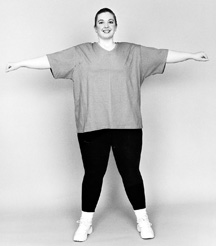 Wear the right clothes:
Wear the right clothes:
- Wear lightweight, loose-fitting tops so you can move easily.
- Wear clothes made of fabrics that absorb sweat and remove it from your skin.
- Never wear rubber or plastic suits. Plastic suits could hold the sweat on your skin and make your body overheat.
- Women should wear a good support bra.
- Wear supportive athletic shoes for weight-bearing activities.
- Wear a knit hat to keep you warm when you are physically active outdoors in cold weather. Wear a tightly woven, wide-brimmed hat in hot weather to help keep you cool and protect you from the sun.
- Wear sunscreen when you are physically active outdoors.
Healthy, fit bodies come in all sizes. Whatever your size or shape, get physically active now and keep moving for a healthier life!
Inclusion of resources is for information only and does not imply endorsement by the Government.
Publications (Fitness-Related)
Walking
. . . A Step in the Right Direction.
NIH Publication No. 01-4155. 2001. This pamphlet explains how to start a walking program, presents a sample program, and shows stretches for warming up and cooling down. Available in English and Spanish from WIN, www.niddk.nih.gov/health/nutrit/nutrit.htm.
Active Living Every Day: 20 Weeks to Lifelong Vitality
Steven N. Blair, Andrea L. Dunn, Bess H. Marcus, Ruth Ann Carpenter, and Peter Jaret, Human Kinetics, 2001. This book offers a step-by-step plan for getting and staying active. The information, suggested activities, and self-help tools in each chapter were successfully tested with people who followed the plan and learned to make activity a part of their daily lives. The 20 chapters correspond to the 20 weeks of the program, but readers are encouraged to go at their own pace. Available from www.humankinetics.com, or your local or online bookstore.
Great
Shape: The First Fitness Guide for Large Women.
Pat Lyons and Debby Burgard. iUniverse, 2000. This book urges women to be physically active for fun, fitness, and positive body image instead of for weight loss. The authors describe a healthy lifestyle program including walking, swimming, dancing, martial arts, bicycling, and more. Available from www.iUniverse.com or your local or online bookstore.
Just
the Weigh You Are: How to Be Fit and Healthy Whatever Your Size.
Steven Jonas and Linda Konner. Houghton Mifflin Co., Ltd., 1998. This book presents a plan for total fitness and healthy living no matter what your size. Chapters focus on accepting oneself, improving nutrition without dieting, managing stress, and doing moderate physical activity. Available from your local or online bookstore.
Don’t
Weight: Eat Healthy and Get Moving NOW!
Kelly Bliss. Infinity Publishing, 2002. This book provides motivation and information for healthy eating and plus-size fitness. It also teaches problem solving techniques. It offers information that can help the large person plan and achieve a fitness program that can be sustained for a lifetime. Available from KellyBliss.com, P.O. Box 572, Lansdowne, PA 19050; phone: 1-877-KellyBliss; Web: www.KellyBliss.com; or your local or online bookstore.
Water
Exercise.
Martha D. White. Human Kinetics, 1995. This book presents water exercises for fitness and muscle tone as well as exercises for injuries, postsurgical rehabilitation, and other special needs. Available from Human Kinetics, P.O. Box 5076, Champaign, IL 61825; phone: 1-800-747-4457; Web: www.humankinetics.com; or your local or online bookstore.
Easy
Does It Yoga.
Alice Christensen, American Yoga Association. Fireside, 1999. This book presents a program of exercises, breathing, meditation, philosophy, and nutrition for older adults and those with physical limitations. Simple chair exercises and more challenging standing and floor exercises are described. Available from the American Yoga Association, P.O. Box 19986, Sarasota, FL 34276; phone: (941) 927-4977; Web: www.americanyogaassociation.org; or your local or online bookstore.
Real Fitness for Real Women: A Unique Workout Program for the Plus-Size Woman.
Rochelle Rice. Warner Books, 2001. This book describes a 6-week introductory fitness program that includes warm-ups, aerobics, strength training and stretching techniques, and meditation. Photos of plus-sized women demonstrate the exercises. The book also addresses getting motivated, creating support, evaluating current abilities, and increasing self-acceptance. Available from www.rochellerice.com or your local or online bookstore.
Other Publications
Ample
Hygiene for Ample People.
Nancy Summer. Willendorf Press, 1997. This booklet offers tips for dealing with reach problems, chafing, skin fold irritations, and more. Available from the National Association to Advance Fat Acceptance, P.O. Box 188620, Sacramento, CA 95818; phone: (916) 558-6880; Web: www.amplestuff.com.
Plus Size Yellow Pages.
Over 3000 online resources for fitness clothes up to 6X, casual wear up to 10X, bikes, bike seats, kayaks, sports bras, supportive tights/leggings, supportive fitness shoes, and much more. Web: www.PlusSizeYellowPages.com
Size Wise: A Catalog of More Than 1000 Resources for Living With Confidence and Comfort at Any Size.
Judy Sullivan. Avon, 1997. This book describes resources that offer products or services for large people. It tells where to buy items like swimsuits, bicycle seats, and walking shoes. It also has information on exercise classes and sports instruction for large people throughout the United States, Britain, and Canada. Available from www.sizewise.com or your local bookstore.
Videos
Yoga for Round Bodies, Volumes 1 and 2.
Linda DeMarco and Genia Pauli Haddon. These videos offer a fitness system based on Kripalu yoga to promote strength, flexibility, stress relief, and cardiovascular health. Round-bodied instructors tailor classic yoga postures to large people at both beginner and intermediate levels in each video. Available from Plus Publications, Box 265-W, Scotland, CT 06264; phone: 1-800-436-9642; or www.amazon.com.
Chair Dancing.
Jodi Stolove. This no-impact video series is designed to improve muscle tone, flexibility, and cardiovascular endurance without putting stress on your knees, back, hips, or feet. Available from Chair Dancing International, Inc., 2658 Del Mar Heights Road, Del Mar, CA 92014; phone: 1-800-551-4386; Web: www.chairdancing.com.
Tai Chi Chuan.
Dawn Fleetwood. This 50-minute instructional video features slow, gentle movements and breathing exercises that involve all of the muscles and organs in the body. Available from Orchid Leaf Productions, P.O. Box 72, Flint, MI 48501; phone: (810) 235-9864.
BIG MOVES: Yoga for Chair and Bed.
Mara Nesbitt. This video is designed for people who have difficulty getting down to or up from the floor. Led by a plus-sized instructor, it includes stretches done standing, sitting, and lying on a bed, plus a guided meditation. Available from Mirage Video Productions, P.O. Box 19141, Portland, OR 97280; Web: www.miragevideos.com.
Organizations and Programs
YMCA
and YWCA.
The Young Men’s Christian Association and Young Women’s Christian Association offer physical fitness and health awareness programs in many locations throughout the United States. Contact YMCA of the U.S.A., 101 N. Wacker Dr., Chicago, IL 60606; phone: (312) 977-0031; Web: www.ymca.net. Contact YWCA of the U.S.A., 1015 18th St., NW, Suite 1100, Washington, DC 20036; phone: 1-800-679-1209; Web: www.ywca.org.
Council
on Size and Weight Discrimination, Inc.
This nonprofit organization seeks to improve health care and access to services for large people through educational programs, media monitoring, and medical conference attendance. Contact CSWD at: P.O. Box 305, Mount Marion, NY 12456; phone: (845) 679-1209; Web: www.cswd.org.
National
Association to Advance Fat Acceptance.
This nonprofit organization seeks to end discrimination based on body size and to improve the quality of life for large people. It offers a variety of publications and videos on size acceptance, self-esteem, and health and fitness. Contact NAAFA at: P.O. Box 188620, Sacramento, CA 95818; phone: (916) 558-6880; Web: www.naafa.org.
Websites
Body
Positive.®
This site addresses issues ranging from self-esteem to fitness to finding
respectful health care providers. It includes resources and links to related
sites. Web: www.bodypositive.com.
Big
Folks Exercise and Fitness Resources Frequently Asked Questions (FAQ).
This site provides information on where to buy clothing, videos, and books on physical activity and fitness for big people. It also lists organizations and classes worldwide for large people. Web: www.faqs.org/faqs/fat-acceptance-faq/fitness.
Healthy Living with Bliss.™
This site includes information on walking, swimming, aerobics, stretching, and other fitness activities for large and very large people. A resource section includes fitness wear, books, exercise equipment, classes, and information on where to buy fitness videos for large people. There is an online workbook, eNewsletter, and a chat with plus-size personal fitness trainer Kelly Bliss. Web: www.KellyBliss.com.
1 Win Way
Bethesda, MD 20892-3665
Phone: (202) 828-1025
Toll-free number: 1-877-946-4627
FAX: (202) 828-1028
Email: win@info.niddk.nih.gov
The Weight-control Information Network (WIN) is a service of the National Institute of Diabetes and Digestive and Kidney Diseases of the National Institutes of Health, which is the Federal Government’s lead agency responsible for biomedical research on nutrition and obesity. Authorized by Congress (Public Law 103-43), WIN provides the general public, health professionals, the media, and Congress with up-to-date, science-based health information on weight control, obesity, physical activity, and related nutritional issues.
WIN answers inquiries, develops and distributes publications, and works closely with professional and patient organizations and Government agencies to coordinate resources about weight control and related issues.
Publications produced by WIN are reviewed by both NIDDK scientists and outside experts. This publication was also reviewed by Steven Blair, P.E.D., President and Chief Executive Officer, Cooper Institute; Robert Eckel, M.D., Professor of Medicine, Physiology, and Biophysics, University of Colorado Health Sciences Center; and Diego Crespo, M.S., Certified Personal Trainer.
Special thanks to the Women of Substance Health Spa, Kelly Bliss, M.Ed., and Rochelle Rice, M.A., of In Fitness and In Health for providing many of the photographs in this brochure.
This publication is not copyrighted. WIN encourages users of this brochure to duplicate and distribute as many copies as desired.
May 2004
